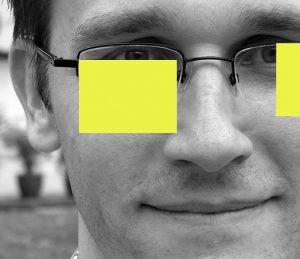Presenting
When you are presenting, do you feel like you are performing? How you think about communication affects how you communicate. For instance, treating public speaking as performance increases anxiety. Business communicators do not deliver a speech; they engage people. Changing how you think about a presentation creates long-lasting changes.
BCC’s consultations begin with two primary questions:
- Who is the target audience?
- What is your argument?
The answer to the first question is sometimes as simple as “the professor.” In business, the target audience is the person or group who influences or drives decisions. For instance, in a presentation to the board of directors, decisions may be driven by a few influential people. Your messages may be compelling. However, if they do not target the decision makers, your arguments will have little impact.
The second question starts a process to discover the primary arguments. Because we do not think in words, this question guides the conversation to the images that make the words powerful. Powerful speakers concentrate on the images they want others to value and remember. It’s all about storytelling; the imagery is the power.
Strategies to improve your communicative behavior
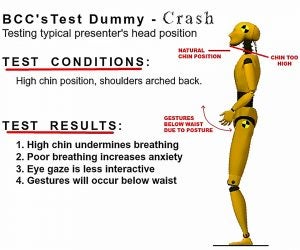
Posture While a powerful voice can offset the distractions of ineffective posture, it’s more challenging to create an impressive voice when posture undercuts your breathing, eye engagement, and gesturing. The example to the left depicts the results of an over-arched back. Strategies to improve your communicative behavior rely on establishing a powerful stance. “Powerful” doesn’t mean a superhero stance, merely a natural stance that enhances other communicative actions. Your posture may feel comfortable, but habits result in “comfortable” stances that are counterproductive to becoming a powerful business communicator.
Crash is shown in various postures in the first two frames on the left below. The captions provide insights into how these postures impact other communicative actions. The two frames on the right exemplify how a jump can allow you to discover how you stand. Typically, when landing a jump, a person will have secondary shifts into a posture that feels comfortable. The initial posture is how you should stand while the secondary movements reflect how habits have altered your posture. If you have had numerous hours of training in dance or athletics, the jump technique may not work. However, there are other strategies so contact the BCC for coaching (bcc@ecu.edu).
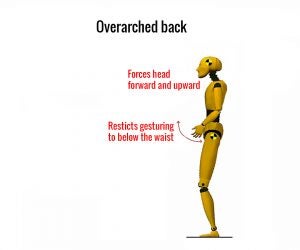

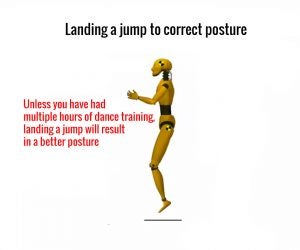
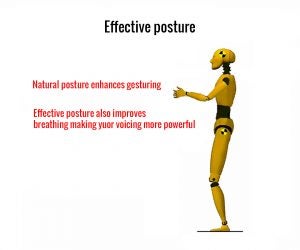
Eye Engagement
Powerful eye engagement becomes part of the imagery business communicators want others to value. While you may have been told to look at foreheads or back walls, you engage people by looking at them. You’ll notice that the eye gaze of the two images on the left below is not synchronized. Unfortunately, this offset pattern, along with eye avoidance and skimming, is quite common. The different directions of the head and gaze in the first image create visual and interactional tension. The second image is a close-up of the eye itself to illustrate the significance of the offset’s angle. While looking askance a few times will not become a distraction, a persistent pattern throughout a presentation will undermine the engagement. The third image illustrates how you can place sticky notes over glasses (prescription glasses or non-prescription sunglasses) to retrain your eye gaze to be synchronized with your head direction and movements. The placement on the side synchs your head and eye movement. The placement below shifts the eye gaze to the center while lowering the head naturally when standing. The head lowers since the sticky note prevents you from seeing people if the chin is too high. This training strategy also improves your voicing and gesturing because a more natural stance improves your breathing and movements.


